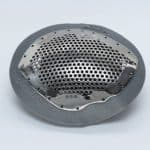Hui Jenny Chen, MD and Michelle Gabriel, MS, MBA
(This blog is adapted from our A Roadmap from Idea to Implementation: 3D Printing for Pre-Surgical Application: Operational Management for 3D Printing in Surgery)
Depending on existing infrastructure, creating an in-house center can be very expensive and require hard-to-find expertise. Often, it is not a viable initial option for smaller medical centers. Except for imaging acquisition, outsourcing is an option along each of the remaining six steps of the 3D printing workflow. Outsourcing these steps allows the medical center to bypass the initial cost/risk and associated operational challenges of creating an in-house service. Currently, several established companies like 3D System(NC, USA) and Materialise (Belgium) provide such services beyond their core businesses, including services on DICOM conversion, segmentation, and printing all-in-one services. The cost of these services can often amount to thousands of dollars. Although the absolute dollar value appears high for such services, in high-risk, rare, and complex surgical cases, the relative cost of adding a 3D printing step is actually tolerable to most healthcare providers.
However, on the other end of the spectrum a larger academic center may be prepared to heavily invest in creating a centralized 3D printing center. The Mayo Clinic was one of the first medical centers to demonstrate its investment (51) It has made significant strides in exploring the innovative use of the technology, creating quality standards, and generating global influence in this field. Almost all the surgical departments, from pediatrics, neurosurgery, to orthopedics, are now routinely using their 3D printing service. The widespread acceptance of the technology within the Mayo Clinic has significantly increased the case volume and helped to justify the cost. It is now one of a few go-to institutions for educating clinicians and 3D printing industries about medical 3D printing, which acts as additional revenue stream.
Providers should consider the following questions when making the decision on creating an in-house 3D printing service versus using outside vendors:
What is the existing infrastructure that could be used for 3D printing?
Existing personnel and software may be available to be part of the new service. For example, several larger hospital systems including Cedar Sinai and the Kaiser Permanente groups have existing funding for innovative projects such as simulation programs that include 3D printing services. Medical centers with comprehensive imaging services are often equipped with high-quality imaging hardware that can generate high-resolution medical images required for 3D printing. Some newer scanners (e.g. GE) are already equipped with existing 3D printing protocols from various popular prosthetics or device companies. Additionally, many imaging and medical centers have purchased licenses for popular 3D visualization software packages such as Vitrea (Vital, USA), which contains many similar post-processing functionalities to other 3D printing specific software. Some of the larger companies like GE and Siemens, are already adding 3D printing functionality into their newest software. Highly-trained technicians who are already familiar with post-acquisition imaging processing already have many of the skills required for 3D printing. The learning curve for these centers will be significantly less steep than a center without experienced personnel in 3D visualization software.
What is the turn around time required for the applications?
Turn around time is a critical factor to consider as many surgical cases are urgent and need to occur in a timely fashion. The medical center needs to identify the slowest point among the production steps and investigate if the most time-consuming step can be performed faster if outsourced. Good and effective communication between the requesting clinicians and the 3D printing team is the most important step to quickly conceptualize the best 3D printing strategy. Because many surgical cases require more timely response, a few major academic hospitals, like Boston Children’s Hospitaland the Mayo Clinic, have officially incorporated 3D printing for surgical planning as part of their Electronic Healthcare Records (EHR). Ineffective initial communication with either in-house or outsourced 3D printing services will prove costly in time and money. The next most time-consuming and labor-intensive step is segmentation and image post-processing. If in-house bioengineering and/or 3D software expertise are already available, then it is much easier to keep this step in-house, since communicating to a multidisciplinary clinical team can be more effective when the engineering step is completed in-house.
On the other hand, some outsource vendors have experienced design/engineering teams who can offer faster printing and shipping/transportation strategies. They may more quickly scale and modify production to shorten turn around time and meet the demand.
What is the equipment needed to achieve the end point?
Software and hardware requirements will highly depend on the goals of the 3D printing center. For example, the resolution and material requirements for creating a pre-surgical educational model for the patients or medical students will be much less than a pre-surgical model intended for a pediatric cardiothoracic surgeon to simulate the intra-operative environment for complex congenital heart disease. Flexible materials which cost significantly more than typically used resins may be needed for pre-surgical models for complex vascular surgery. The size of the model required will also help determine what hardware is needed. For example, a pediatric heart model is small enough to fit inside the popular desktop SLA printer Form 2 (FormLabs , USA) but an actual sized adult pelvis will not fit.
How much does the clinical team want to be involved in the printing process?
In general, when extensive multidisciplinary communication among different clinical and engineering teams is needed, an in-house 3D printing service is intuitively more efficient and convenient for rapid prototyping and correction of errors and defects in the model. The cost and time of re-designing and reproducing a model will increase significantly with outsourcing.
Again, the steps where clinical team involvement can occur are variable depending on individual cases. For example, in complex maxillofacial cases where the surgeons often want to see a variety of surgical strategies, it may make sense to keep the design/segmentation steps in-house and outsource the final printing with an outside vendor. Models intended for educating patients (patients’ families) and students/residents usually do not require extensive in-house multidisciplinary discussion and can be outsourced easily.
What to look for when selecting for an outsource vendor for pre-surgical 3D printing:
Given the promise of the healthcare market, more and more 3D printing companies are now interested in providing services to healthcare providers. Because of isolation from the healthcare facility, it is important for outsource vendors to understand and respect the sensitive nature of the medical record. It is imperative to prepare a HIPAA compliant data transfer process. Currently, some hospitals use LifeImage (MA, USA) as a way to transfer images. For complex cases, the ability to effectively communicate with the radiologist and treating clinicians requires the vendor to have certain healthcare familiarity or clinical experience. Even with experienced vendors, occasional unsatisfactory products may still be produced and it is important that the vendors can provide adequate customer service to either effectively rectify the mistakes or design backup plans in case of such failure. For example, making multiple versions of the prints with different design or structural emphasis is one such strategy.
Table V summarizes the pros and cons for in-house and outsourced solutions. Many facilities will start with a combination of in-house and outsource services. Depending on the clinical needs, medical centers now have many choices in combining the two services to achieve optimal results. There is also a new growing trend of collaborative works between specialized 3D printing companies with large healthcare systems. (53)

Table V. In House vs. Outsourcing: Pros and Cons




 Jan 04, 2017
Jan 04, 2017 






Comments